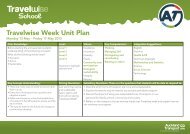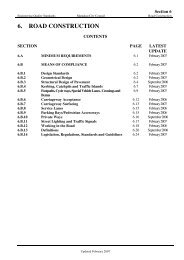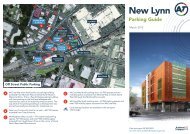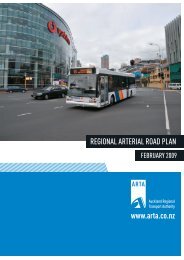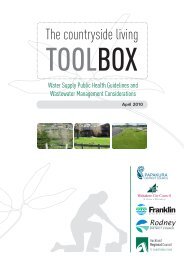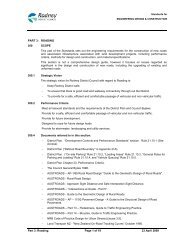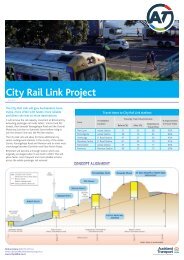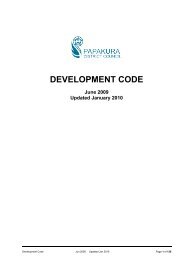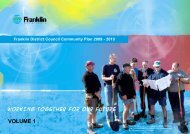Regional Land Transport Programme 2009 - 2010 (2MB) - Auckland ...
Regional Land Transport Programme 2009 - 2010 (2MB) - Auckland ...
Regional Land Transport Programme 2009 - 2010 (2MB) - Auckland ...
You also want an ePaper? Increase the reach of your titles
YUMPU automatically turns print PDFs into web optimized ePapers that Google loves.
5 THE <strong>2009</strong>/12 PROGRAMME<br />
20<br />
The <strong>Auckland</strong> RLTP Preparation Process<br />
A critical part of preparing the RLTP is prioritising all proposals received<br />
from Approved Organisations (AO). This allows funding to be allocated<br />
to the highest priority activities in times when funding is limited.<br />
The funding of a programme of works is divided into three processes:<br />
> Funding prioritisation<br />
All proposals submitted to ARTA are first ranked to create a list<br />
of activities in priority order. This allows the whole programme to<br />
be ranked in order of importance, using the profiling process<br />
described below. Many of the submitters to previous LTPs<br />
commented that no single process can effectively prioritise<br />
activities from all areas of the region and across all transport<br />
modes; and concern was raised that the benefit/cost analysis<br />
used favoured roading activities at the expense of other modes<br />
of transport. The NZTA has addressed these concerns to some<br />
extent by lowering the discount rate and making changes to the<br />
value of time for public transport users. The net effect of these<br />
changes is to improve the benefit/cost ratio of expensive projects<br />
which have long-term benefits such as rail improvements and<br />
public transport projects to gain a more equal footing when<br />
compared against activities which advantage private vehicles.<br />
ARTA’s profiling process, as described below, has been designed<br />
to address these concerns. It should also be noted that when<br />
allocating funding, schemes are compared with similar types of<br />
schemes and monies distributed from distinct ‘pots‘, (called<br />
activity classes) so that for example, cycling schemes are<br />
compared with other cycling schemes and their funding comes<br />
from an allocated share of the total resources.<br />
> Project profiling process<br />
The profiling process is designed to ensure the RLTP gives effect<br />
to the RLTS and is consistent with the desired impacts of the<br />
Government Policy Statement (GPS). It has been developed in<br />
ARTA’s ATP with its longer-term view and strategy focus on<br />
integrated land use and transport development. The process is<br />
similar to the proven process used for the 2008/09 LTP and is also<br />
similar to the NZTA profiling process. The main point of difference<br />
is that ARTA has amended the Seriousness and Effectiveness<br />
criteria to ensure consistency with the guidance given in the May<br />
<strong>2009</strong> GPS while maintaining the ability of the prioritisation<br />
process to give effect to the RLTS, whereas the NZTA has replaced<br />
Seriousness and Urgency with Strategic Fit and altered the<br />
Effectiveness criteria. ARTA believes the changes we have made<br />
to the prioritisation process enable the RLTP to give effect to the<br />
RLTS, and be consistent with the GPS.<br />
The profiling process first extracts core items such as previously<br />
committed activities, maintenance and public transport service<br />
subsidies to be placed in the programme. ARTA chose to treat<br />
maintenance and public transport services as essential, and they<br />
are therefore funded before all other projects which are<br />
considered discretionary. Next, improvement activities are ranked<br />
to establish those projects to be included in the programme.<br />
><br />
Each activity is rated on:<br />
> The Seriousness of the issue being addressed.<br />
> The Effectiveness of the proposed solution in addressing the<br />
issue identified and in delivering regional/national strategic<br />
objectives.<br />
> The economic Efficiency (or benefit/cost ratio) of the<br />
proposed solution.<br />
In addition to the above factors, the urgency of a project is also<br />
considered, to rank the priority of projects with the same<br />
’Seriousness‘ rating. For instance, road works planned adjacent to<br />
the Western railway line, which is currently being duplicated, may<br />
need to be carried out before the double tracking is completed.<br />
Each project is rated High, Medium or Low (H, M or L) for each<br />
of the three factors resulting in a profile (e.g. HHM).<br />
Next, each project is considered for strategic balance. Strategic<br />
balance is a method of allocating funding to areas or types of<br />
project which may be under-represented. For example, as the<br />
transport problems in <strong>Auckland</strong> tend to be dominated by the<br />
urban areas, the rural transport problems could potentially be<br />
overlooked, but strategic balance gives the opportunity to redress<br />
the imbalance. In providing this strategic balance, the priority of<br />
each activity is still considered. Ensuring adequate transport<br />
provision for the Rugby World Cup 2011 is another example.<br />
Finally, in order to rank projects with the same profile, a points<br />
system is used which takes into account the extent to which<br />
projects align with:<br />
> The ‘Strategic Focus Areas’ stated in Chapter 4 – Statement<br />
of Priorities.<br />
> The short-term challenges as stated in Chapter 3.<br />
Appendix 2 provides a detailed description of this prioritisation<br />
process.<br />
Funding approval<br />
For the RLTP, the NZTA gives final funding approval for activities<br />
when the relevant phase of the activity is fully developed. Approval<br />
for construction funding requires that there are no impediments<br />
to construction starting, i.e. all consents must be in place prior to<br />
funding approval. Exceptions to this include ongoing maintenance<br />
and operational and administration programmes, which are often<br />
long-term contracts lasting at least three years – these are<br />
approved at the beginning of the financial year.<br />
The NZTA uses two stages when allocating funding to activities:<br />
> “N” funding is allocated first on the basis of national priority<br />
order within each activity class.<br />
> “R” funding is allocated to proposed activities that were not<br />
judged to be of sufficient national priority to be funded by N<br />
funds, but are considered important by the region.<br />
When the three-year National <strong>Land</strong> <strong>Transport</strong> <strong>Programme</strong> is<br />
released in August <strong>2009</strong>, some activities are approved for funding<br />
by the NZTA, but most are approved during the following three<br />
years, after monthly reviews with ARTA.



